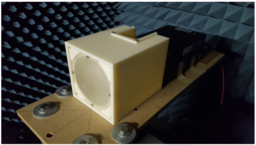Polarization-Independent Spatial Power Divider for a Common Aperture Two-Port MMW Antenna
TECHNOLOGY NUMBER: 2020-250

OVERVIEW
A polarization independent spatial power divider that allows for better radar target identification- Use of a dual-polarized, two-port device with a common aperture for the transmitter and receiver
- Permits operation of two spatial power dividers that split electromagnetic waves into reflected and transmitted
BACKGROUND
Radar is a crucial technology for autonomous vehicles as it enables them to sense and detect objects in their surroundings, thereby improving obstacle detection and reducing the incidence of collisions. An essential component of this evolving technology is the millimeter-wave radar for middle- to long-range sensing. Also high imaging resolution and semantic mapping will be required for path finding and to better assess the threats. Enhancing cross-range resolution involves achieving a narrower antenna beamwidth, which can be attained by enlarging the electrical dimensions of the antenna aperture.
Many millimeter-wave radar systems utilize two separate antennas for transmit and receive, with some separation distance between them for high isolation. However, this approach has drawbacks including large antenna sizes as well as radar parallax, a circumstance where the transmit and receive beams are only well aligned over a limited range of target distances. Radars with a much higher resolution than the currently utilized 24-77 GHz range will be required for application such as collision warning and adaptive cruise control. As such, a need exists for improvements in radar technology to better guide autonomous vehicles.
INNOVATION
Researchers have designed a polarization independent spatial power divider using a planar metamaterial slab which allows for better target identification. The antenna system employs a dual-polarized, two-port device with a common aperture for both the transmitter and receiver. This approach facilitates the determination of both horizontal and vertical sizes of an object. The technology contains designs for two spatial power dividers, one that operates at 79 GHz and a second that operates at 230 GHz. Those power dividers split an electromagnetic wave incident at 45 degrees into a reflected and transmitted wave, providing equal reflection and transmission for both polarizations over their operating bandwidth. A micro-machining fabrication is used to create the spatial power divider, employing an anisotropic material with lower dielectric constant for transverse electric polarization than for transverse magnetic polarization as the spatial power divider. This anisotropic dielectric material is implemented by using a dielectric with periodic corrugations. The end result is a novel technology which fosters a significantly improved means by which to utilize radar for autonomous vehicle guidance.
PATENT APPLICATION
Number: US20210344123
-
expand_more mode_edit Inventor (3)Adib NashashibiKamal SarabandiTanner Douglas
-
expand_more library_books References (1)
- Douglas TJ, and Sarabandi K. , Two-Port, Common Aperture, High-Isolation, Dual-Polarized Sub-Millimeterwave Antenna System Based on Spatial Power Divider.2019 IEEE International Symposium on Antennas and Propagation and USNC-URSI Radio Science Meeting, 2019, pp. 501-50210.1109/APUSNCURSINRSM.2019.8888741
-
expand_more cloud_download Supporting documents (1)Product brochurePolarization-Independent Spatial Power Divider for a Common Aperture Two-Port MMW Antenna.pdf